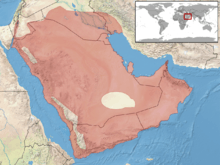Cerastes gasperettii
| Cerastes gasperettii | |
|---|---|
.jpg) | |
| Scientific classification | |
| Kingdom: | Animalia |
| Phylum: | Chordata |
| Class: | Reptilia |
| Order: | Squamata |
| Suborder: | Serpentes |
| Family: | Viperidae |
| Genus: | Cerastes |
| Species: | C. gasperettii |
| Binomial name | |
| Cerastes gasperettii Leviton & S. Anderson, 1967 | |
 | |
| Synonyms[2] | |
| |
Cerastes gasperettii, commonly known as the Arabian horned viper, is a venomous viper species found especially in the Arabian Peninsula[2] and north to Israel, Iraq, and Iran. It is very similar in appearance to C. cerastes, but the geographic ranges of these two species do not overlap.[5] No subspecies of C. gasperettii are recognized.[6]
Etymology
The specific name, gasperettii, is in honor of John Gasperetti, an American surveyor, engineer, and herpetologist, who collected the holotype specimen.[7][8]
Description
The average total length (including tail) of C. gasperettii is 30–60 cm (12–24 in), with a maximum total length of 85 cm (33 in). Females are usually larger than males.[3]
Geographic range
In the Arabian Peninsula C. gasperettii has been found in Saudi Arabia, Kuwait, Oman, Qatar, United Arab Emirates, and Yemen. It is found in the Arava valley, located on the border between southern Israel and Jordan, eastwards through Jordan and Iraq to Khuzestan Province in southwestern Iran.[1]
The type locality given is "Beda Azan [23°41'N., 53°28'E.], Abu Dhabi [Abū Zaby]" [United Arab Emirates].[2]
See also
- List of viperine species and subspecies
- Viperinae by common name
- Viperinae by taxonomic synonyms
References
- 1 2 Egan DM, Amr ZSS, Al Johany AMH, Els J, Pappenfuss T, Nilson G, Sadek R, Disi AM, Hraoui-Bloquet S, Werner YL, Anderson S (2012). "Cerastes gasperettii". IUCN Red List of Threatened Species. IUCN. 2012: e.T164599A1060588. Retrieved 5 July 2018.
- 1 2 3 McDiarmid RW, Campbell JA, Touré T (1999). Snake Species of the World: A Taxonomic and Geographic Reference, Volume 1. Washington, District of Columbia: Herpetologists' League. 511 pp. ISBN 1-893777-00-6 (series). ISBN 1-893777-01-4 (volume).
- 1 2 Mallow D, Ludwig D, Nilson G (2003). True Vipers: Natural History and Toxinology of Old World Vipers. Malabar, Florida: Krieger Publishing Company. 359 pp. ISBN 0-89464-877-2.
- ↑ Mehrtens JM (1987). Living Snakes of the World in Color. New York: Sterling Publishers. 480 pp. ISBN 0-8069-6460-X.
- ↑ Spawls S, Branch B (1995) The Dangerous Snakes of Africa. Dubai: Ralph Curtis Books. Oriental Press. 192 pp. ISBN 0-88359-029-8.
- ↑ "Cerastes gasperettii ". Integrated Taxonomic Information System. Retrieved 30 July 2006.
- ↑ Werner YL (2002). "Middle Eastern herpetology loses John Gasperetti, 1920-2001". Zoology in the Middle East 27: 5-6.
- ↑ Beolens, Bo; Watkins, Michael; Grayson, Michael (2011). The Eponym Dictionary of Reptiles. Baltimore: Johns Hopkins University Press. xiii + 296 pp. ISBN 978-1-4214-0135-5. (Cerastes gasperettii, pp. 98-99).
Further reading
- Farag AA, Banaja A (1980). "Amphibians and Reptiles from the western region of Saudi Arabia". Bull. Fac. Sci. King Aziz Univ., Riyad 4: 5-29.
- Joger U (1984). The Venomous Snakes of the Near and Middle East. Wiesbaden: Dr. Ludwig Reichert Verlag. 175 pp. ISBN 3-88226-199-4.
- Leviton AE, Anderson SC (1967). "Survey of the reptiles of the Sheikdom of Abu Dhabi, Arabian Peninsula. Part II. Systematic account of the collection of reptiles made in the Sheikdom of Abu Dhabi by John Gasperetti". Proc. California Acad. Sci., Fourth Series 35: 157-192, 12 figures, 8 tables. (Cerastes cerastes gasperettii, new subspecies, pp. 183–186, Figure 12, Table 5).
- Werner YL, Le Verdier A, Rosenman D, Sivan N (1991). "Systematics and zoogeography of Cerastes (Ophidia: Viperidae) in the Levant: 1. Distinguishing Arabian from African “Cerastes cerastes” ". The Snake 23: 90-100.
External links
- Cerastes gasperettii at the Reptarium.cz Reptile Database. Accessed 2 August 2007.
